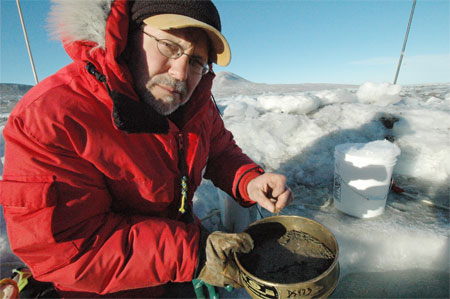|
Rock stars of scienceOne USAP participant admits to being a different type of groupiePosted February 20, 2009
A few years ago, as I ate a solitary late dinner in the McMurdo Station I’ve always been a sucker for the smart ones. As a teen, I would not have given 10 cents to meet Robert Redford or the Beatles, but would have run over hot coals to have had the chance to visit with Thomas Jefferson or Albert Einstein. My parents, small Iowa farmers, instilled in me an insatiable thirst to learn more — about everything. The first thing I noticed about my husband, when first laying eyes on him 20 years ago in grad school, was that he was browsing through the chemistry and physics books at the local book store. He’s smart, I told myself, and he’s handsome! What more could a person want? Even though I married a chemist, it wasn’t until two years later, when I met a Russian solar physicist, when it dawned on me that it really is the scientists who impress me most. I did well in science, but had chosen the social sciences for my career path, becoming a teacher of history and political science. Ten years ago, I gave up teaching and went to Antarctica for what I thought would be a one-season stint. About a month after arriving in McMurdo, I encountered Sridhar Anandakrishnan For the past eight years, I have been the Communications specialist for Raytheon Polar Services I fell head over heels in love with biologist Sam Bowser The current object of my science-infatuation is John Madey, inventor of the Free Electron Laser. John has never been to Antarctica, but he grew up communicating with Antarctic scientists via ham radio in the 1950s. I interviewed him over the phone recently for a story I wrote about those early days of communication. [See related story: Past connections.] When I went home that evening, I couldn’t contain my excitement as I described the conversation to my husband. “This man invented the Free Electron Laser!” Luckily, I have a very patient husband. And it appears I’m not alone in my infatuation with scientists. During my dining date with MacAyeal, our conversation turned to what he enjoys about deploying year after year. “At home, I’m just one of any number of anonymous scientists on campus, but here we’re treated like royalty. People flock to us [scientists] here, wanting to learn more about what we’re studying. I should be so lucky to have such attention in my classroom. Plus, the scientific equipment and support we have access to here is every scientist’s dream.” It’s true. Ask USAP participants what they like most about the program, and they will tell you it is the people. Where else can you eat breakfast with a penguin scientist, lunch with an astrophysicist, dinner with a global warming expert and then go for a late night ski with a marine biologist? OK, it’s true that a university campus may afford the same opportunities, but they also bring added distractions, such as term papers to write. On the Ice, even if you never liked science as a student, you will most certainly acquire a greater appreciation for it. So, if you see a 50-year old lady chasing a scientist down the hallway, begging for an autograph, it may be me. They’re my rock stars. |



For USAP Participants |
For The Public |
For Researchers and EducatorsContact UsU.S. National Science FoundationOffice of Polar Programs Geosciences Directorate 2415 Eisenhower Avenue, Suite W7100 Alexandria, VA 22314 Sign up for the NSF Office of Polar Programs newsletter and events. Feedback Form |




